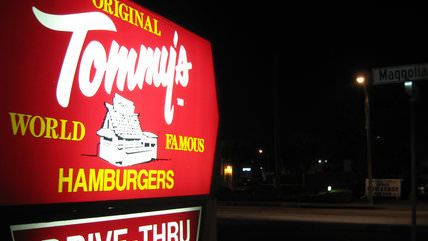Obesity Rose Most in Areas of L.A. Where Fast Food Openings Were Banned
Magic bullet Fail


Since 2008, new fast food establishments have been banned from opening in South Los Angeles, as part of the city council's attempt to nudge citizens towards making healthier food choices. This week Rand Corp. reports that since the regulation took effect, the obesity rate in L.A. has grown everywhere, with significantly greater increases in neighborhoods covered by the ordinance.
Between 2007 and 2012, the obesity rate in South L.A. rose from 63 percent to 75 percent, according to Rand Corp, which analyzed data from the UCLA Center for Health Policy Research. In other parts of L.A. county, the obesity rate rose from 57 percent to 58 percent. From the Los Angeles Times:
"What has changed? Well, nothing," said Roland Sturm, lead author of the study and a senior economist at Rand, who called the restriction symbolic.
The report contradicts statements from the nonprofit Community Health Councils, which fought to uphold the restriction by citing county figures showing a 3% drop in obesity.
Councilman Bernard C. Parks, who co-wrote the zoning restriction with former Councilwoman Jan Perry, said … the ordinance was meant to be part of a larger strategy that includes bringing grocery stores and farmers markets to replace fast-food restaurants, but that part has been more difficult to accomplish.
As Matt Welch pointed out in 2010, this is an area of the city that could desperately use some jobs. Health issues aside, what the city council has done is prevent new businesses that actually would open in (and bring jobs to) South L.A. from doing so while failing to bring alternative businesses (and jobs) to the area. Meanwhile, the ban hasn't accomplished any of its intended health goals either.
Some will say the ban's failure to thwart rising obesity is because the zoning rule didn't go far enough: "The zoning rule was very specific," the Times notes. "Applying only to stand-alone restaurants with limited menus, items prepared in advance or prepared quickly, no table orders and disposable containers," the rule "didn't target many of the places that serve unhealthy food." But American food is by and large unhealthy. Targeting everywhere that served unhealthy food would include most restaurants, convenience stores, and supermarkets. Even if every existing fast-food joint in South L.A. shut down, residents could still find meals every bit as bad at the grocery store or sit-down restaurant or corner bodega.
Lawmakers want one type of eatery, one offending beverage, one no-no nutrient that, if abolished from American diets, will reverse the course on this whole obesity trend. Because what we actually need is a lot more nuanced and a lot tougher sell: widespread shifts in cultural atittudes toward food; increases in nutrition knowledge; and overhauling of food policies that kill innovation and subsidize the foods that are killing us. You can see why lawmakers prefer to focus on limiting the number of McDonald's.
"Researchers agree that even without an empirical effect, policies can start conversations that change societal norms," the Times states. Gwendolyn Flynn, nutrition policy director for Community Health Councils, "has noticed that at community meetings in South L.A., there is often fruit and water among the pastries and soda. 'That's huge,'" she said.
It might sound radical, but perhaps community meetings could provide fruit and water without a banning economic activity from South L.A.?
Here's Reason TV on the ban in 2011:


Show Comments (13)